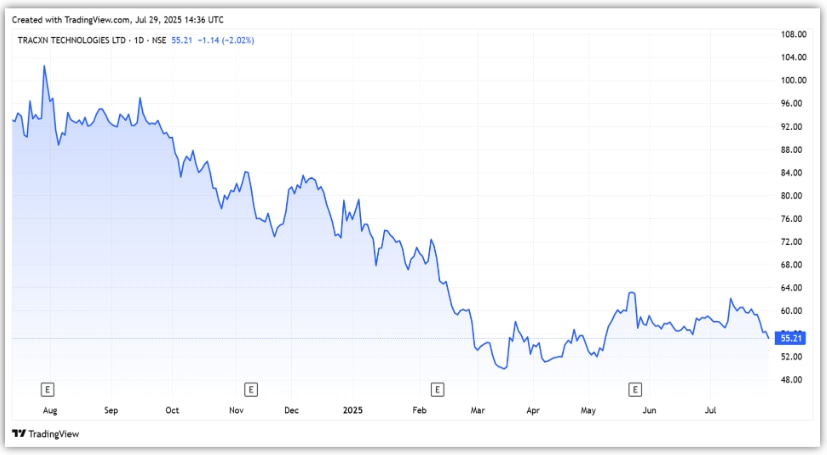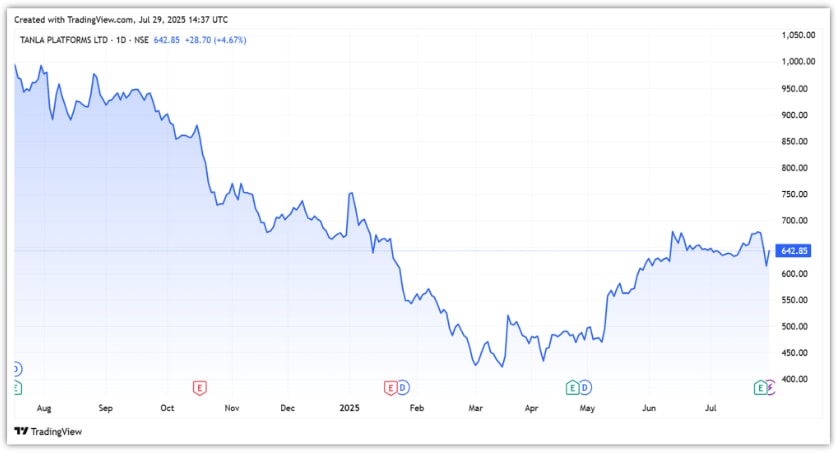Even as the broader market remains volatile, amid record selling by insiders and promoters, two companies are buying back their shares. Notably, this comes at a time when they have sold shares worth $30 billion in the first half of 2025. As a result, promoter holdings in the listed companies now stand at a seven-quarter low of 50.1% in Q4FY25.
Positively, two companies are buying back their shares. For companies, buybacks are often a means of returning cash to shareholders, or they do it because they think their shares are undervalued. So, what prompted them to buy back?
Here’s a close look at both of them..
#1 Tracxn Technology
Tracxn tracks and curates data on startups, making it available on a subscription basis through the Tracxn platform. It tracks over 4 million entities, over 72,900 investors, and over 786,000 transactions.
The company’s client base includes the investment industry (venture capital, private equity, family offices), corporate (consultancies, companies, corporate strategy), and other (government agencies and universities).
Buyback at 40% Premium
Tracxn’s share price has fallen by over 53% from ₹ 118 in January 2024 to the current ₹ 55. It is now buying back 1.0 million shares, about 1% of the outstanding equity shares, at ₹ 75. This buyback price is about 40% higher than its current level.

The buyback size of ₹800 million is quite large as it represents 23.7% of its capital and reserves. It aims to return surplus cash to shareholders, optimize capital structure, and bolster earnings per share and return on equity (ROE) by reducing the equity base.
India Gains Share as Global Revenue Slips
Its operation spans over 50 countries, with India, the US, the UK, Singapore, and Germany among its top 5 countries. International revenue accounts for 60% of revenue in FY25, while India accounts for 40%. Notably, the share of revenue from India has increased from 30% in FY21 to 40%.
However, while its India revenue grew 18% to ₹335 million in FY25, led by the launch of vertical teams, international revenue remained sluggish, declining 6% to ₹510 million. This was due to the subdued private market, mergers and acquisitions activity, and a slowdown in funding.
In total, Tracxn’s revenue rose just 2% to ₹845 million. The company reported a ₹95 million net loss in FY25, down from a ₹65 million profit last year. A seven-fold jump in deferred tax expense to ₹157 million hurt its net profit. Excluding this, net profit declined 24% to ₹49 million.
The company’s customer accounts jumped about 50% to 1,926 in Q4FY25, up from 1,312 in Q4FY24. It now has 46 clients in the ₹2 million revenue bracket (up from 40 in FY24), 22 in the ₹3 million bracket (22 in FY24), and 19 in the ₹4 million bracket (19 in FY24).
Growth Initiatives Show Early Traction
Looking ahead, the company says it is seeing early signs of recovery among international customers, with volumes growing 26% in FY25, against a 5% decline in FY24. Volumes in India also rose 65%, compared to 20% growth a year earlier.
It is also pursuing growth initiatives. It has built a large organic inbound traffic funnel, which saw a strong response. It recorded over 21 million visits in FY25, up 3x over the last three years.
It has also launched ‘Tracxn Lite’ to showcase its product. In just over a year since launch, Lite has recorded more than 1,39,000 sign-ups. Monthly active users have crossed 30,000. Organic sign-ups have nearly tripled (2.7x). Average monthly activity has quadrupled (4.4x).
The company has also launched specialised teams for startups, universities, investment banks, and corporate sales. This strategy is also yielding positive results. It now covers 1.1 million companies with detailed financials.
Valuations at a Discount to Historical Averages
Tracxn now trades at a market cap-to-sales multiple of 7x, a 30% discount to the 3-year median of 10x.
#2 Tanla Platforms
Tanla Platforms is a market leader in the communications platform-as-a-service (CPaaS) business with a 30% market share. It enables companies to communicate with their customers and intended recipients. It’s ubiquitously present across SMS, Voice, OTT (WhatsApp, Truecaller), Chatbot, etc.
It has a 35% market share in data security, privacy, spam, and scam detection, and processes over 800 billion transactions annually, accounting for approximately 63% of India’s A2P SMS traffic. It serves BSNL, Vodafone Idea, and Airtel in India.
In addition, it serves over 2,000 clients across various industries, and serves 8 of the top 10 brands in the banking, retail, e-commerce, and tourism sectors. It maintains high customer engagement, and its relationships with 50 of the top 100 accounts are more than 5 years old.
Buyback at a Steep Premium
Tanla’s share price has declined 69% from its all-time high of ₹2,061 in January 2022 to ₹642 today. It is now buying back 2 million equity shares, about 1.5% of total equity shares, at ₹ 875. This buyback size is ₹1.75 billion, and is priced about 36% higher than its current level.

The company offers two products. Enterprise Communications provides communication services. On the other hand, it also operates digital platforms such as TrueBlock, Wisely, and Wise Albert.
Enterprise Growth Holds Steady, Platforms Face Pressure
Enterprise revenue grew 3% year-on-year to ₹37 billion in FY25, accounting for 91% of total revenue. On the other hand, Digital Platform revenue declined 1.3% to ₹3.6 billion, accounting for 9% of total revenue. Overall, its revenue rose 2.5% to ₹40 billion. A total of 322 customers contributed over ₹10 million in annual revenue.
However, net profit fell 7% to ₹5.1 billion as margins contracted 140 basis points to 17.2%. Despite this, its free cash flow grew 19% to ₹5.1 billion, representing 13% of revenue and 100% of net profit.
Shifting Focus to Platform Play and Global Expansion
Looking ahead, Tanla is experiencing a challenging industry environment marked by pricing pressure and shifting channel preferences. To counter this, it is doubling down on platform solutions and expanding in the international market to push growth. As a result, management expects better performance in FY26.
Tanla trades at a price-to-earnings multiple of 17x, well below its 10-year median of 25x.
Conclusion
Despite sluggish growth and declining profitability, both Tracxn and Tanla Platforms are opting for buybacks at a sizable premium, signalling confidence in their business models and a possible undervaluation by the market. These moves also come at a time when promoter selling is rising, making them stand out. While near-term headwinds persist, their focus on new growth initiatives and improving customer traction may offer some comfort.
Disclaimer
Note: Throughout this article, we have relied on data from http://www.Screener.in and the company’s investor presentation. Only in cases where the data was not available have we used an alternate but widely used and accepted source of information.
The purpose of this article is only to share interesting charts, data points, and thought-provoking opinions. It is NOT a recommendation. If you wish to consider an investment, you are strongly advised to consult your advisor. This article is strictly for educational purposes only.
Madhvendra has been deeply immersed in the equity markets for over seven years, combining his passion for investing with his expertise in financial writing. With a knack for simplifying complex concepts, he enjoys sharing his honest perspectives on startups, listed Indian companies, and macroeconomic trends.
A dedicated reader and storyteller, Madhvendra thrives on uncovering insights that inspire his audience to deepen their understanding of the financial world.
Disclosure: The writer and his dependents do not hold the stocks discussed in this article.
The website managers, its employee(s), and contributors/writers/authors of articles have or may have an outstanding buy or sell position or holding in the securities, options on securities, or other related investments of issuers and/or companies discussed therein. The articles’ content and data interpretation are solely the personal views of the contributors/ writers/authors. Investors must make their own investment decisions based on their specific objectives, resources, and only after consulting such independent advisors as may be necessary.

